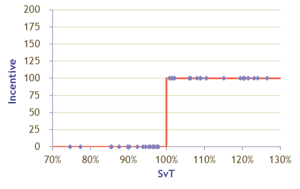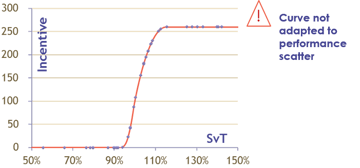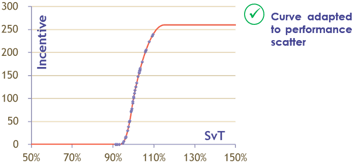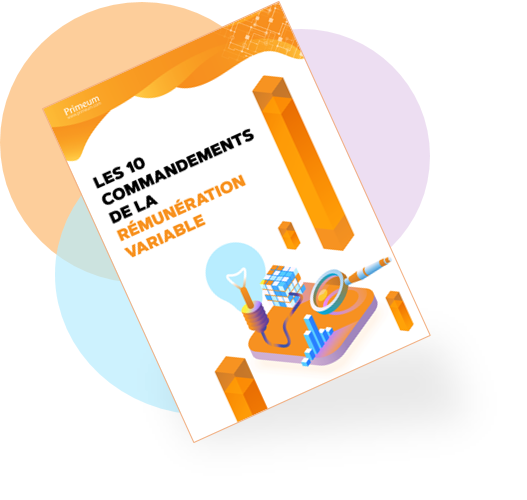Several methods are used to calculate incentive compensation: sales vs target bonus, commissioning, ranking, etc. However, in order to be effective and boost the motivation of salespeople, companies choose a mixed model that they can vary according to the profile and performance of each employee.
1. THE MOST USED: SALES VS TARGET BONUS BY STEP AND COMMISSIONING
Step-by-step compensation and commissioning are the two most used forms of calculation. As a reminder, step-by-step compensation is directly associated with one or more measurable objectives. It assumes a result requirement and is unlocked by step according to the achievement or not of the result and its overtaking. As for the commissioning, it consists in paying the employee on the basis of a percentage of turnover or margin that he brings back to the company.
However, these two calculation methods are often not 100% efficient. Firstly, they depend directly on the correct definition of the objectives to be achieved by the commercial, which means that they will be defective if the objectives are poorly defined. Then, they establish a system in which each level releases a higher level of remuneration. If the trader is, within a few days of his deadline, without having reached the top, he will tend not to invest, since his chances of reaching the next level are low.
 It is a perverse effect of poorly designed incentive scheme that encourages people to stop their efforts if the next level is evaluated too difficult to achieve in order to preserve business for the next period. Secondly, commissioning by not issuing a requirement may cause problems of motivation in the long term and creates annuity effects on salesmen with a well-established client portfolio which guarantees them a high remuneration without too much efforts to provide.
It is a perverse effect of poorly designed incentive scheme that encourages people to stop their efforts if the next level is evaluated too difficult to achieve in order to preserve business for the next period. Secondly, commissioning by not issuing a requirement may cause problems of motivation in the long term and creates annuity effects on salesmen with a well-established client portfolio which guarantees them a high remuneration without too much efforts to provide.
2 RANKING: A MODEL CLOSE TO THE BUSINESS GAME
Ranking is probably the simplest method of variable pay system. It simply consists of ranking salespeople according to their performance and paying them according to their rank. Its great advantage for the commercial departments is the control as soon as the launch of the budget envelope is spent. However, it is not frequently used because it has a major drawback: turn the objectives achievement into a business game.
Not only it does not foster the development of some qualitative objectives such as customer satisfaction, but it tends to develop a competition between salespeople that can harm the success and effectiveness of the team as a whole. This method of compensation is used more for incentive (bonus in kind, gift, or cash).
3. MODELING YOUR INCENTIVE SCHEME: USE A CONSULTING TOOL
You have defined in a personalized manner, and according to your resources, your sales and turnover objectives ... It must be the same for the method of calculating the incentive compensation of your sales representatives. In order to be effective, stimulating and motivating, it must be aligned with the profiles and objectives that are submitted to your employees.
In practice, this adequacy is reflected in a payout curve that must be adapted to the dispersion of performances that follow a normal law ... A little technical, but it actually allows to create a bonus-on-target model where your entire team has interest in reaching performance. It is therefore essential to make an estimation of the dispersion of the compensation of your teams, then to calibrate the pay curve from which the scale is derived. To do this without difficulty, if you are a SME or Start-up, you can use the consulting tool that offers payout curves according to the dispersion of the performance history of your teams.
In addition, if your teams are numerous and your business strategy is complex, it will be more relevant to be accompanied by a compensation consulting agency like Primeum.
4. RISKS OF AN INADEQUATE INCENTIVE COMPENSATION SCHEME
Be careful ! Av incentive scheme can be considered defective if it is not adapted to the dispersion of the performances of your team: too much left on one side and too many big winners


This leads you to neglect a part of the sales force, while a minority will be overpaid without being necessary. Such a distribution will decrease the motivation of your team and negatively impact its long-term performance.
It is preferable to set up a system that positions the majority of your employees on the useful part of the curve. This will allow you to remunerate your agents at various levels and effectively track their progress. You will also be able to readjust the payout curve more easily according to their progress, while making it a valid tool for motivation and additional performance.




